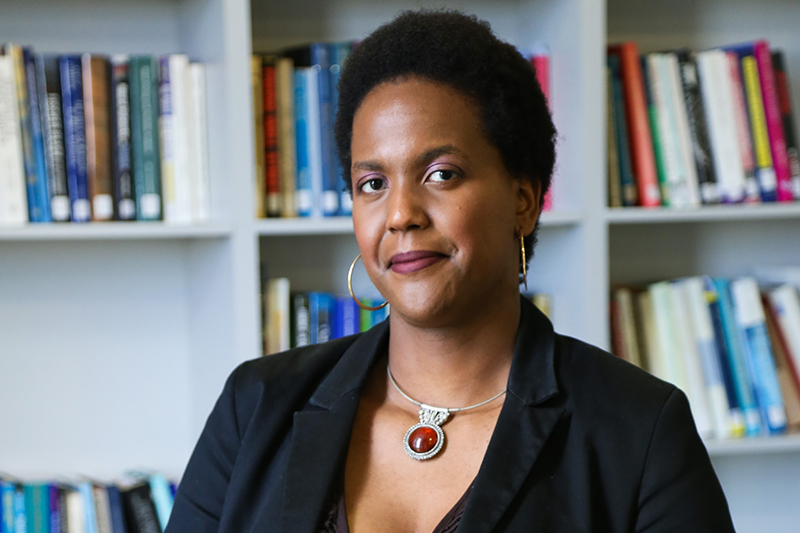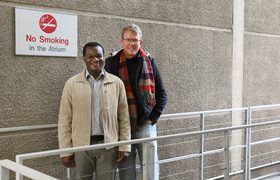The real state of the nation: study the data
09 March 2018 | Story Samantha Richmond. Photo Robyn Walker. Read time 8 min.
To honour Nelson Mandela’s legacy of a better life for all, President Cyril Ramaphosa will need to look at hard data on the state of the nation, Samantha Richmond wrote in Business Day recently. Richmond is senior operations manager at the National Income Dynamics Study (NIDS), implemented by UCT’s Southern Africa Labour and Development Research Unit (SALDRU).
All eyes are on President Cyril Ramaphosa to see if he can deliver on the promises made in his inaugural State of the Nation Address (SONA) last month. After months of political uncertainty, the ship – as Trevor Manual put it after the address – finally appears to have a captain at its helm. For the first time in 10 years, there is hope that South Africa may now be able to go somewhere.
Since Ramaphosa’s narrow victory at the ANC's elective conference at Nasrec in December, the new leadership of the ruling party has hinted at adopting new policies that are noticeably more radical. The SONA took this further, outlining several bold new approaches and affirming the government’s commitment to “radical economic transformation”.
As critics pointed out afterwards, the speech was thin on detail and big on ideas. And indeed, his words only hold real promise for the future of the country if they are to be accompanied by sound policy reforms based on empirical evidence.
Devil in the detail
A big part of moving forward must lie in understanding what has worked and not worked up to now. Fortunately, there is plenty of data to show us the real state of the nation – including from the government’s own research initiatives.
NIDS, for example, is a Department of Planning, Monitoring and Evaluation funded panel (longitudinal) study that has been following the lives of the same approximately 28 000 South Africans and those they live with since 2008, with the aim of informing policy and monitoring policy implementation. It is in its fifth data production phase, having completed its fifth wave (or round) of data collection during 2017.
The data collected by NIDS sheds much-needed light on the shifting lived realities of South Africans. Because it is a long-term study of the same people, it offers researchers and policymakers the unique opportunity to understand what is changing – or not changing – as well as what is influencing these changes (or lack thereof).
NIDS provides empirical insights into various aspects of the lives of South Africans on everything from health, education and household income to employment patterns, and points to how these are interlinked. Crucially, it also shows us what factors are effectively helping those South Africans who are currently living in poverty to exit poverty.
One recent analysis, which used NIDS data and data from the 1993 Project for Statistics on Living Standards and Development, for example, found that one of the main drivers of ongoing income inequality in South Africa was people’s earnings – which are inherently unequal, primarily due to the large number of people who have no labour market.
More specifically, the analysis undertaken by UCT researchers Janina Hundenborn, Murray Leibbrandt and Ingrid Woolard found, among other things, that: a) although income inequality has fallen slightly over the past 20 years, it remains unacceptably high and that b) the primary driver of income inequality is labour market income.
Higher education unlocks potential
Within this context, one could therefore argue that the educational path to higher earnings is important as it offers South Africans a route out of poverty. For this reason, the government’s commitment to former President Jacob Zuma’s parting gift of free higher education to poor households must be welcomed. NIDS data has pointed to the reality that access to post-secondary education, and by extension the potential for higher earnings, is constrained by socio-economic circumstances.

The analysis by UCT researchers Nicola Branson and Amy Kahn found that poorer households have lower levels of enrolment in post-secondary education, with university enrolees having better academic performance and tending to come from higher-income households. This lack of access to post-secondary education in turn contributes to skills shortages, which leads to high rewards for the skilled and lower rewards for the unskilled. Essentially the unskilled are more likely to remain poor – and so are their children.
“Essentially the unskilled are more likely to remain poor – and so are their children.”
Moreover, their analysis found that enrolment patterns at technical and vocational education and training colleges and universities seem to be due to a combination of socio-economic status, scholastic performance (only about half of youth starting school finish secondary school and very few of those qualify to enrol at university), and financial means (which suggests insufficient opportunities for funding).
But before we get too enthusiastic about free higher education, additional analyses using NIDS data have shown that factors contributing to access to education, and ultimately earning potential, effectively start at birth. According to an analysis by Daniela Casale, the nutritional health of the child from birth can have a profound impact on them in later years.
Early childhood nutrition is key
The analysis found that children who were stunted routinely performed more poorly than their peers, and that the negative impact of their poor nutrition was sustained. Children who were stunted had completed fewer years of schooling by age 14 and this may later end up giving their peers a head start in the job market. Even after controlling for age at first enrolment, the analysis showed that stunted children tended to progress slower through the schooling system, meaning a potential reduction in their lifetime earnings.
In this light, Ramaphosa’s commitments to focus more policy attention on early childhood development must also be welcomed.
Putting the findings of these and other analyses based on NIDS data (of which there are many) together, delivers a dismal “state of the nation”. Income inequality remains high, with barriers to education performance and earning potential linked to poor nutrition and financial access to post-secondary education – creating a self-perpetuating cycle.
Honest, solution-driven policy going forward must consider empirical data, such as that produced by NIDS, and offer integrated support to tackle these challenges, and there are multiple areas that can contribute positively.
Social grants not enough
Social grants, for example, as Ramaphosa alluded to in his SONA, have played a strong part, with a demonstrable impact thus far for the time period covered in Hundenborn et al’s paper showing average income from grants more than doubling, as did the proportion of households receiving them.
Their analysis further showed that government grants have proven to be one of the core factors lowering overall income inequality and reducing the constraints for very low-income households over the past two decades. But they are not sufficient. We urgently need to find ways to also boost people’s earnings through skills development and job creation.
Going forward, sustained nutritional support for pre-school and school learners, additional funding reforms that enable greater access to post-secondary education across the economic spectrum, and long-term policy reforms that create an enabling environment for entrepreneurs and job creation could all hold potential for real shifts.
Undoubtedly, Ramaphosa and his new team have their work cut out for them. Fortunately, the evidence that can help them make the best choices possible is there – should they choose to examine it.
 This work is licensed under a Creative Commons Attribution-NoDerivatives 4.0 International License.
This work is licensed under a Creative Commons Attribution-NoDerivatives 4.0 International License.
Please view the republishing articles page for more information.










